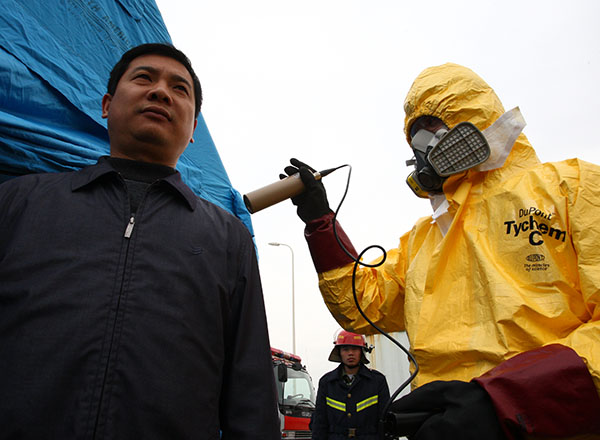ZHAO LEI
(China Daily) Updated: 2016-01-28 03:25
 |
|
A nuclear leakage emergency drill is held in Zhuhai, south China's Guangdong province on March 11, 2013. [Photo/CFP] |
China is to form a national nuclear emergency response task force to handle any serious accidents and to take part in overseas operations.
Xu Dazhe, head of the China Atomic Energy Authority, said the task force will comprise 320 professionals and will work with the existing 25 nuclear emergency teams to conduct search and rescue operations after a nuclear accident.
The 25 teams have more than 1,300 personnel.
Xu said China has eight technical support centers and three training bases involved in nuclear emergency response efforts. In addition to increasing staffing levels, the country is drafting laws on nuclear energy and nuclear security.
Xu made the remarks at a news conference in Beijing on Wednesday to mark the release of a white paper titled China's Nuclear Emergency Preparedness — the first of its kind in the country. The news conference was hosted by the State Council Information Office.
China, which began building its first nuclear power station in 1985, has 30 reactors in operation with an installed capacity of 28.3 gigawatts. Twenty-four more are under construction, according to the China Atomic Energy Authority.
At present, nuclear power contributes about 2 percent of China's electricity generation, according to the China Electricity Council. Xu said that last year eight reactors became operational and work started on six new ones.
The government is considering building offshore nuclear power plants, but only under completely safe conditions, Xu said, adding that a "careful and scientific" feasibility review will be carried out before a decision is made.
Since China established its nuclear industry in the 1950s, the government has attached great importance to nuclear safety and emergency response.
In 1991, the State Council set up a national committee to handle any nuclear emergencies. In 1997, the government issued a national nuclear emergency plan and has since revised it several times. The latest version was released in June 2013.
National nuclear emergency response drills were organized in 2009 and 2015 and a third will be staged soon, Xu said.
Liu Senlin, vice-president of the China Institute of Atomic Energy, said the nation has at least 300 nuclear and radioactive monitoring vehicles and also boasts a full-scale emergency detection system.
"Every provincial-level region now has its own detection vehicles. In addition, at least four aerial monitoring systems are being used by several ministries," he said, adding that China uses the most advanced nuclear and radioactive monitoring technologies.
